Lesson 4
Square Roots on the Number Line
4.1: Notice and Wonder: Diagonals (5 minutes)
Warm-up
This warm-up transitions from work in previous lessons and prepares students to locate square roots on a number line in this lesson. Students must use the structure of the circle to relate the length of the segment to a point on the number line (MP7).
Launch
Arrange students in groups of 2. Tell students that they will look at an image, and their job is to think of at least one thing they notice and at least one thing they wonder. Display the image for all to see. Ask students to signal when they have noticed or wondered about something. Give students 1 minute of quiet think time, and then 1 minute to discuss the things they notice with their partner, followed by a whole-class discussion.
Student Facing
What do you notice? What do you wonder?

Student Response
For access, consult one of our IM Certified Partners.
Activity Synthesis
Ask students what the exact length is (it should be familiar to them from earlier lessons). The focus of the discussion is how you can see the decimal approximation from the diagram by looking at where the circle intersects an axis.
4.2: Squaring Lines (10 minutes)
Activity
In this activity, students determine the length of a “diagonal” line segment on a grid. Students can give an exact value for the length of the line segment by finding the area of a square and writing the side length using square root notation. The goal of this activity is for students to connect values expressed using square roots with values expressed in decimal form—a form they are more familiar with.
Monitor for students who draw a tilted square for the first problem during the first two minutes of work time. Then monitor for students who use the following strategies to find the length of the segment:
- drawing a square and finding the area
- using tracing paper
- using a compass to make a circle
Launch
For this activity, it is best if students do not have access to a calculator with a square root button. If student calculators do have a square root button that students are familiar with, tell students that their explanations about their answers to the second problem need to dig deeper than pressing a button. In later lessons, however, they will be able to use it.
Before students begin, remind students that “exact length” means it can’t just be an approximation, so if it is not a rational number, we should write it with square root notation. For example, a square with area 17 has a side length of exactly \(\sqrt{17}\), which is a little larger than 4, since \(4^2=16\).
Begin by displaying the diagram for all to see. Ask students how this diagram is similar and how it is different from the diagram in the warm-up. Then 2–3 minutes after students begin working, pause the class and select a previously identified student who drew a square on the grid to share what they did and why. Give 2–3 minutes work time to finish the problems followed by a whole-class discussion.
Supports accessibility for: Visual-spatial processing; Organization
Student Facing

- Estimate the length of the line segment to the nearest tenth of a unit (each grid square is 1 square unit).
-
Find the exact length of the segment.
Student Response
For access, consult one of our IM Certified Partners.
Activity Synthesis
Select students to present in this sequence:
- Someone who drew a square and used the area to find the exact side length.
- Someone who used tracing paper. This is essentially like the number line as a ruler. Ask students what this tells us about the exact value we found with the square. (\(\sqrt{10}\) is about 3.1.)
- Someone who used a compass to find the approximate side length. This is a more formal geometric construction, but it is just another way to use the number line as a ruler.
Design Principle(s): Support sense-making
4.3: Square Root of 3 (10 minutes)
Activity
In previous activities and lessons, students found the exact area of a square in order to find an approximation for the square root of an integer. In this activity, students start with a square root of an integer, and draw a square to verify that a given approximation of the square root is reasonable. This is the first time students have seen or drawn squares that do not have vertices at the intersection of grid lines, so it may take them a few minutes to make sense of the new orientation.
Launch
Give students access to four-function calculators. Display the diagram for all to see. Ask students what is the same and what is different about this diagram and diagrams they have seen in earlier activities. Arrange students in groups of 2. Give students 2–3 minutes of quiet work time followed by partner and whole-class discussions.
Supports accessibility for: Language; Organization
Design Principles(s): Optimize output (for explanation); Maximize meta-awareness
Student Facing
Diego said that he thinks that \(\sqrt{3}\approx 2.5\).
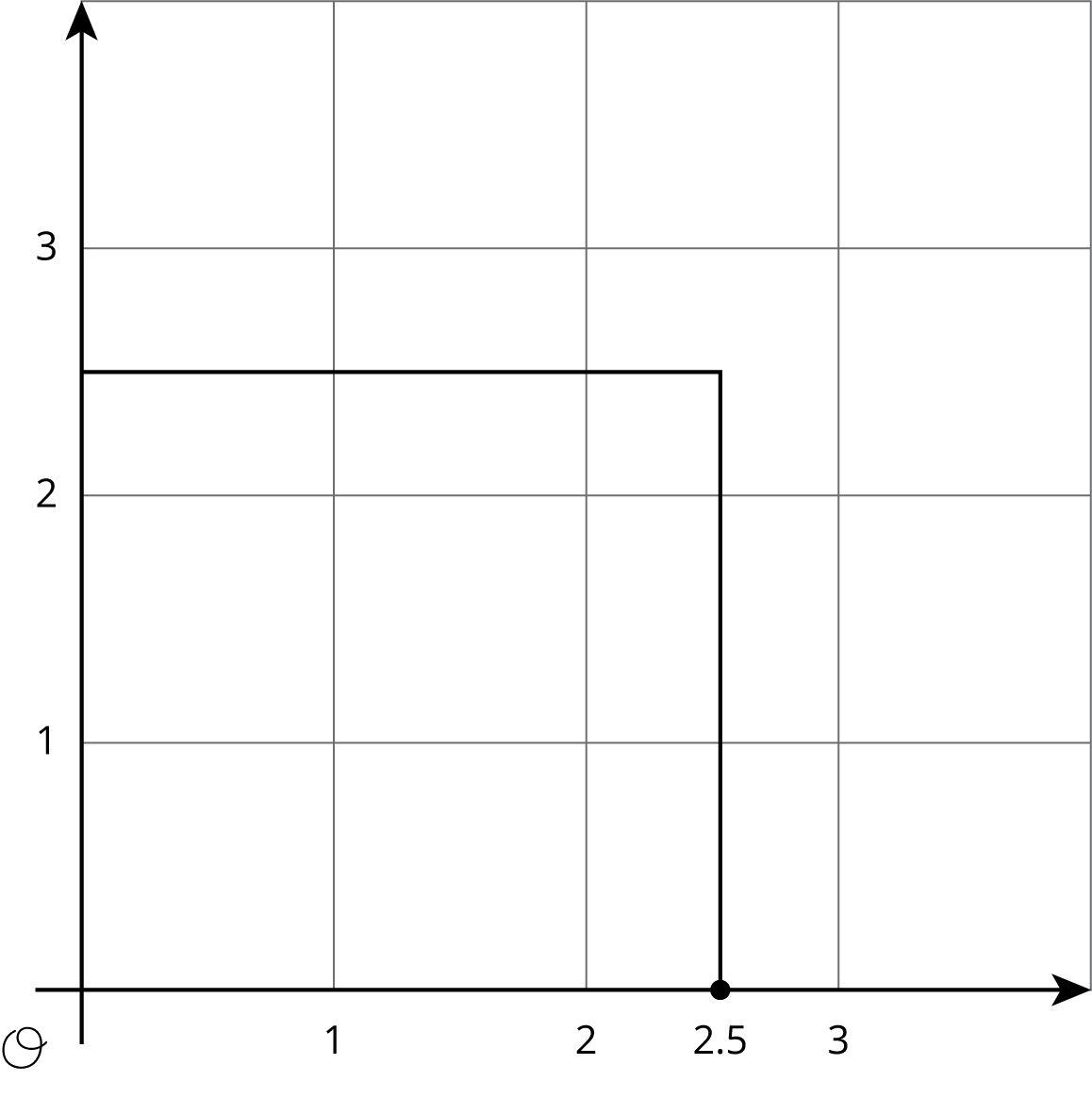
- Use the square to explain why 2.5 is not a very good approximation for \(\sqrt{3}\). Find a point on the number line that is closer to \(\sqrt{3}\). Draw a new square on the axes and use it to explain how you know the point you plotted is a good approximation for \(\sqrt{3}\).
-
Use the fact that \(\sqrt{3}\) is a solution to the equation \(x^2 = 3\) to find a decimal approximation of \(\sqrt{3}\) whose square is between 2.9 and 3.1.
Student Response
For access, consult one of our IM Certified Partners.
Student Facing
Are you ready for more?
A farmer has a grassy patch of land enclosed by a fence in the shape of a square with a side length of 4 meters. To make it a suitable home for some animals, the farmer would like to carve out a smaller square to be filled with water, as in the figure.
What should the side length of the smaller square be so that half of the area is grass and half is water?
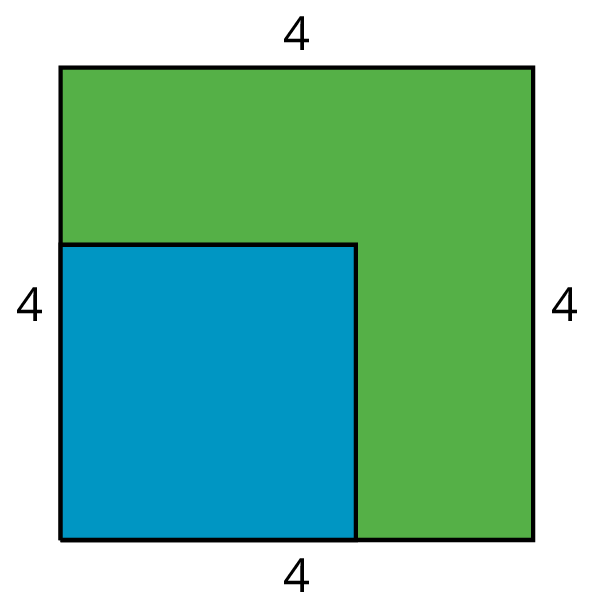
Student Response
For access, consult one of our IM Certified Partners.
Activity Synthesis
Invite one or two students to share their squares. Then tell students, “The square of a point on the number line can be visualized as the area of a literal square. This can help us estimate the value of a square root. Simply squaring the number can as well. Let’s check the squares of some numbers that are potential approximations of \(\sqrt{3}\).”
Then ask students to suggest decimal approximations, and check together as a class by finding their squares. Students should be using each guess to make a better guess next. For example, if they try 1.5, then the square is 2.25, which is too low. This suggests trying bigger. Because we know that 2 is too big (because \(2^2 = 4\), it should be somewhere in between 1.5 and 2.) For example, students might suggest this order:
\(1^2 = 1\) and \(2^2=4\)
\(1.5^2 = 2.25\)
\(1.8^2 = 3.24\)
\(1.7^2 = 2.89\)
\(1.72^2 = 2.9584\)
\(1.73^2 = 2.9929\)
So 1.73 is a pretty good approximation of \(\sqrt{3}\).
Lesson Synthesis
Lesson Synthesis
The goal of this discussion is to check that students know how to approximate square roots. In the previous lesson, students learned that some square roots, \(\sqrt{2}\) in particular, are not rational. But they are still numbers, and we can reason about their approximate value using more familiar numbers.
- “How can you approximate the value of \(\sqrt{130}\)?” (\(\sqrt{130}\) is somewhere between 11 and 12 because \(11^2 = 121\) and \(12^2 = 144\).)
- “So we know \(\sqrt{130}\) is somewhere between 11 and 12. Can we get more accurate than that? How?” (We could try squaring numbers from 11 to 12 like 11.1, 11.2, etc. . . to find the one closest to 130.)
4.4: Cool-down - Approximating $\sqrt{18}$ (5 minutes)
Cool-Down
For access, consult one of our IM Certified Partners.
Student Lesson Summary
Student Facing
Here is a line segment on a grid. What is the length of this line segment?
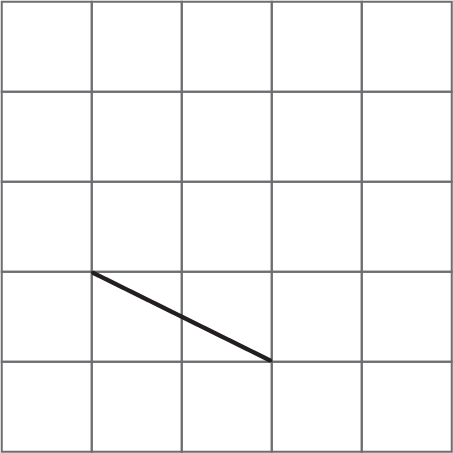
By drawing some circles, we can tell that it’s longer than 2 units, but shorter than 3 units.
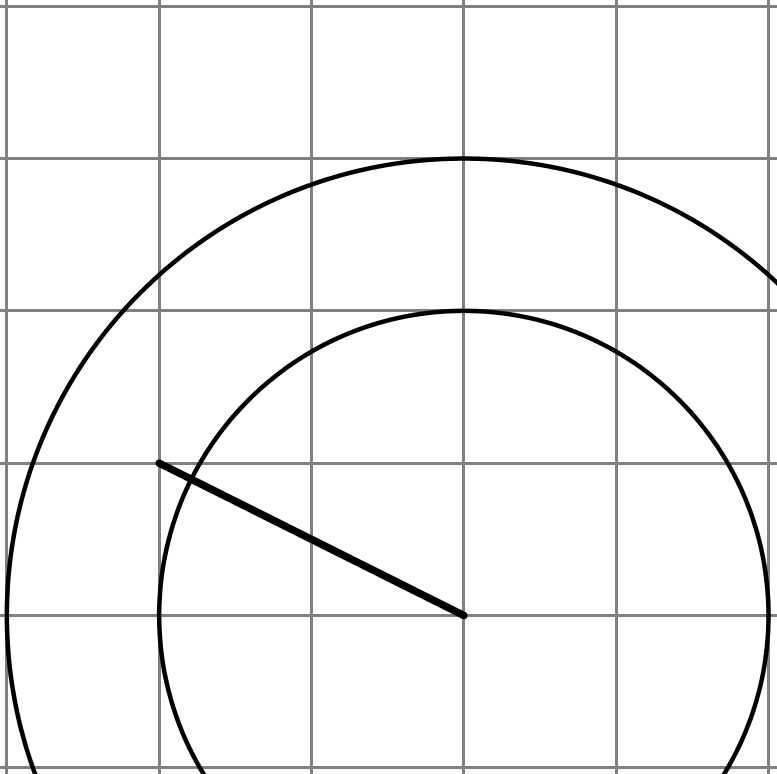
To find an exact value for the length of the segment, we can build a square on it, using the segment as one of the sides of the square.
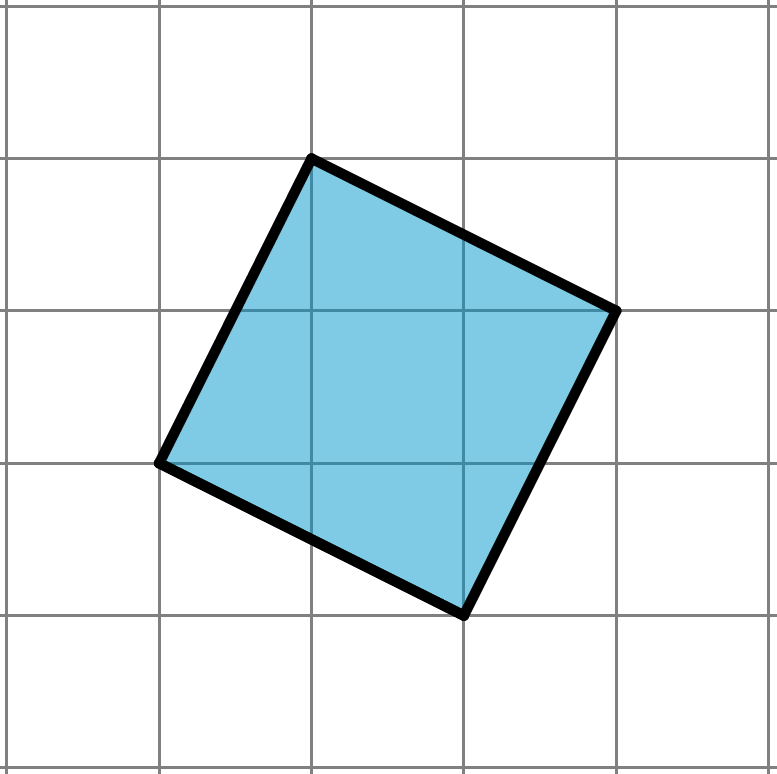
The area of this square is 5 square units. (Can you see why?) That means the exact value of the length of its side is \(\sqrt5\) units.
Notice that 5 is greater than 4, but less than 9. That means that \(\sqrt5\) is greater than 2, but less than 3. This makes sense because we already saw that the length of the segment is in between 2 and 3.
With some arithmetic, we can get an even more precise idea of where \(\sqrt5\) is on the number line. The image with the circles shows that \(\sqrt5\) is closer to 2 than 3, so let’s find the value of 2.12 and 2.22 and see how close they are to 5. It turns out that \(2.1^2=4.41\) and \(2.2^2=4.84\), so we need to try a larger number. If we increase our search by a tenth, we find that \(2.3^2=5.29\). This means that \(\sqrt5\) is greater than 2.2, but less than 2.3. If we wanted to keep going, we could try \(2.25^2\) and eventually narrow the value of \(\sqrt5\) to the hundredths place. Calculators do this same process to many decimal places, giving an approximation like \(\sqrt5 \approx 2.2360679775\). Even though this is a lot of decimal places, it is still not exact because \(\sqrt5\) is irrational.